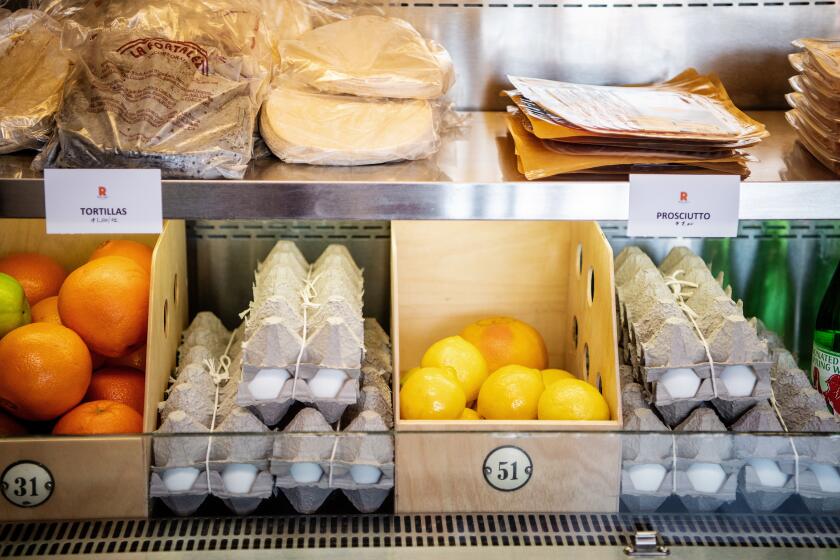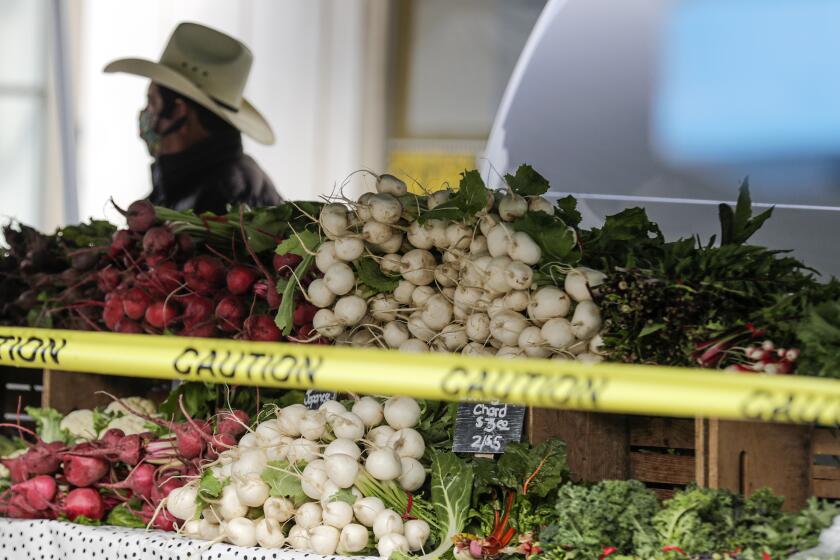Restaurant vendors are now selling to the public. Here’s why it might hurt them instead of help.
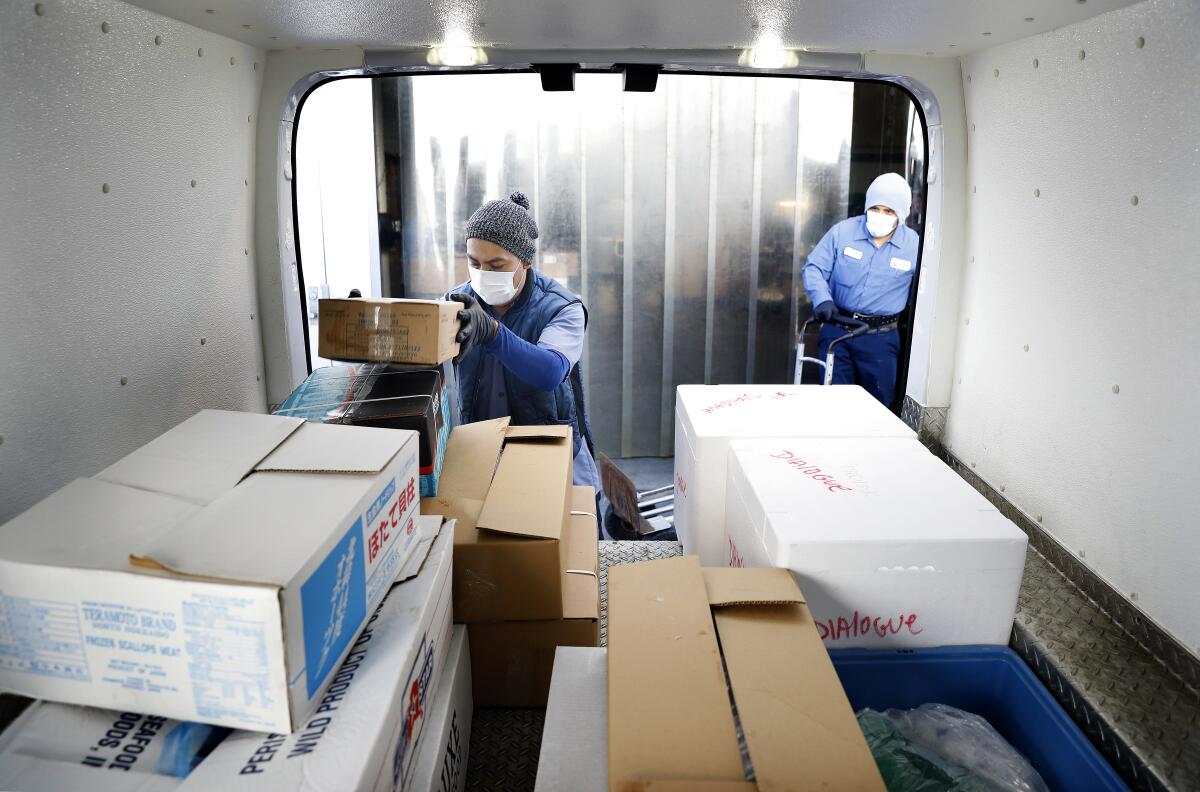
- Share via
Two weeks ago, a delivery driver in a white sprinter van arrived at my house with two cardboard boxes packed with ice. Inside was an oceanic treasure trove: 10 pounds of Scottish salmon, a 5-pound filet of yellowtail from Japan, a 2-pound chunk of ruby-red Bigeye tuna from Hawaii, frozen jumbo shrimp and a jar of pearlescent orange trout roe.
The previous day I’d placed an email order with Luxe Seafood, a high-end seafood distributor that sells to some of the city’s most respected sushi bars and restaurants, including Sushi Gen, Mori Sushi, Hayato, Providence, Spago and 71Above.
Like most restaurant suppliers, Luxe Seafood saw its business fall off a cliff once dining rooms closed due to the COVID-19 pandemic. Since mid-March, wholesale orders have been down at least 80%, Chief Executive Thomas Chen said.
“The majority of our customers are the premium sushi and white-tablecloth restaurants, and they’ve been hit hardest by the closures,” he said.
But are home deliveries viable for business? Not even close, Chen said. “Each transaction is so much lower than a restaurant, it’s not really possible to make money.”
When restaurants are operating normally, questions of product margins and delivery logistics are hidden, or at least obscured, from the average diner, who sees a final price on the menu and judges accordingly. The realities of the pandemic, though, have revealed the rickety framework underneath.
These L.A. restaurants now sell groceries, produce boxes, dry goods, beer and wine and more.
“Everything about the industry is being reshaped, and I don’t think anyone can say when it goes back to normal,” said Steve Grandjean, owner of Gourmet Imports, a cheese and specialty food distributor in Alhambra. “But right now it’s showing that food and labor have been undervalued for a long time.”
But with few revenue opportunities on the table, many wholesalers are giving direct-to-consumer a go.
A few weeks into the shutdown, Luxe announced on Instagram it would begin offering home delivery of seafood and grocery items across L.A. County and parts of Orange County. There’s a $100 minimum per order; $150 gets you free delivery.
Chen said that although Luxe has always sold to the public, it wasn’t a popular option. Individual customers weren’t seeking fresh and frozen seafood in bulk and it wasn’t practical for the company’s fleet to make deliveries meager in comparison to what the average restaurant orders. The shutdown, however, changed all that.
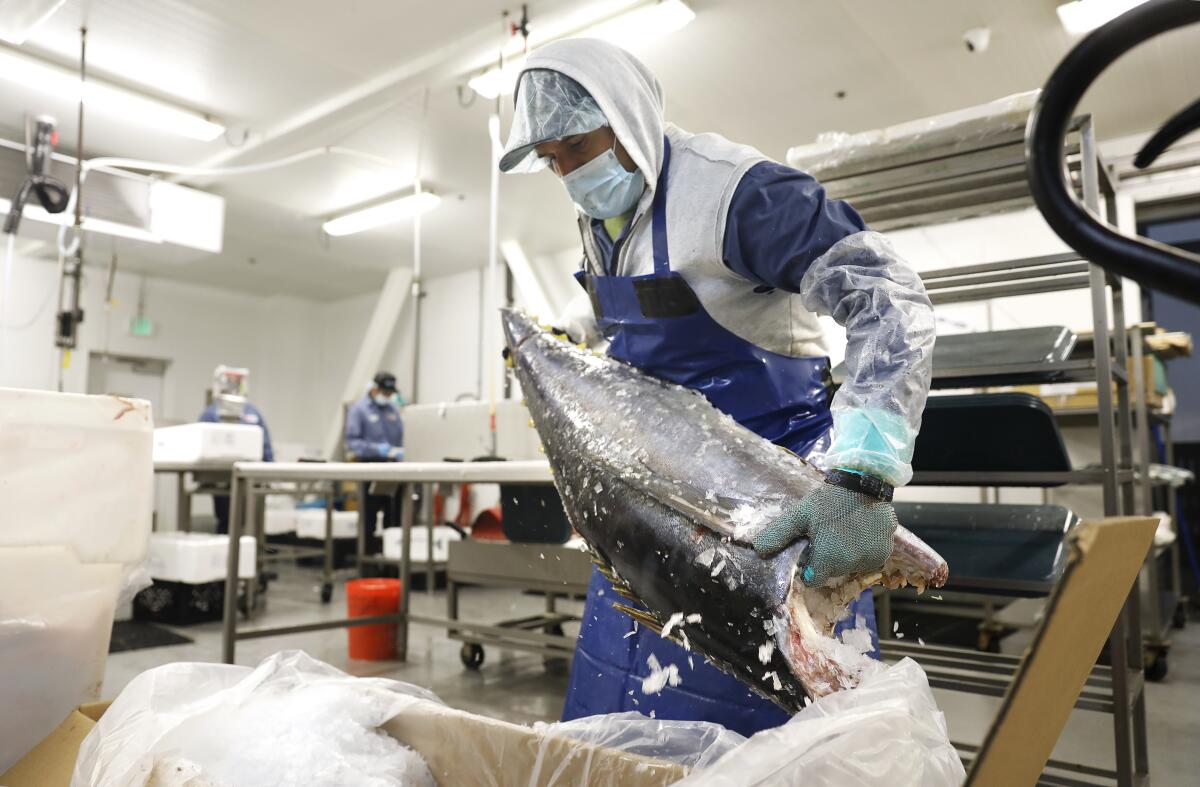
“Home delivery gave us something to do, honestly,” Chen said. “It helped keep our drivers on the payroll, and it provided people with a way to get seafood and vegetables without going to the market. I think our product is much better quality than supermarket grade.”
Third-generation family-run wholesaler Nature’s Produce is offering items such as artichokes, seedless watermelon and mangoes on its website — order minimum $50 — for will-call pickup at its warehouse in Vernon or delivery via DoorDash.
Meat purveyors including Rocker Bros., Premier Meat Co. and West Coast Prime Meats — places that supply restaurants such as Bestia and Animal — are selling Kumamoto A5 Japanese Wagyu and dry-aged rib-eye via delivery, pickup and shipping.
Chefs’ Warehouse, a distributor that supplies some 35,000 restaurants around the country, recently announced that for the first time it would sell its products — meat, seafood, olive oils, bread and dairy — online and offer free home delivery for orders over $250 (local pickup is available for orders over $100).
For some vendors, opening warehouses to retail customers is a straightforward way to meet growing demand for groceries and offset losses. But for others, selling to the public offers more drawbacks than benefits.
Grandjean said he had considered selling to the public initially but decided doing so would infringe on the many local cheese shops he supplies.
“I don’t want to compete with people that buy from me, especially in a landscape that’s already devastated,” he said.
Home delivery is also cost-prohibitive for most distributors, he said.
“Our standard calculation is that it takes a $250 order minimum just to break even. For restaurants that’s no problem, but for an individual customer it’s less likely.”
These are unprecedented times for farmers, accustomed to selling produce to restaurants. Many have shifted to CSA boxes and other methods to cope
Due to the decline in business, Grandjean furloughed 80% of Gourmet Imports workers on March 26. The few drivers he still employs are mainly doing drop-offs to the handful of restaurants that have transitioned into markets.
“Chefs that might only take whole animals before, now they’re looking for prosciutto that’s presliced, prepackaged. That’s what customers are buying now,” he said.
Amid what Grandjean called “economic pain in every direction,” companies like Gourmet Imports find themselves in an unenviable situation. Their future depends almost entirely on restaurants, the same businesses that are least capable of paying them right now.
“Vendors usually get the short end of the stick. We get paid last,” he said. “If you’re a chef, you have to take care of staff and rent first, I understand that. But we also have to pay our staff.”
Grandjean said that after speaking with his company’s accountant, he believes a quarter of the money currently owed to his company will never be recouped or is otherwise “uncollectible.”
Matt Parker, who owns gourmet mushroom distributor Shiitake Happens, said he currently has $60,000 to $90,000 in invoices he expects will never be paid.
“If a restaurant isn’t able to pay, what’s our option? Not sell to them? It becomes this massive game of financial chicken,” Grandjean said. “Relationships you’ve spent years building will be tested.”
For home consumers, however, connecting with wholesalers has its upsides: scoring premium ingredients — such as sushi-grade fish — at wholesale, or near-wholesale prices, while saving money and supporting a small businesses.
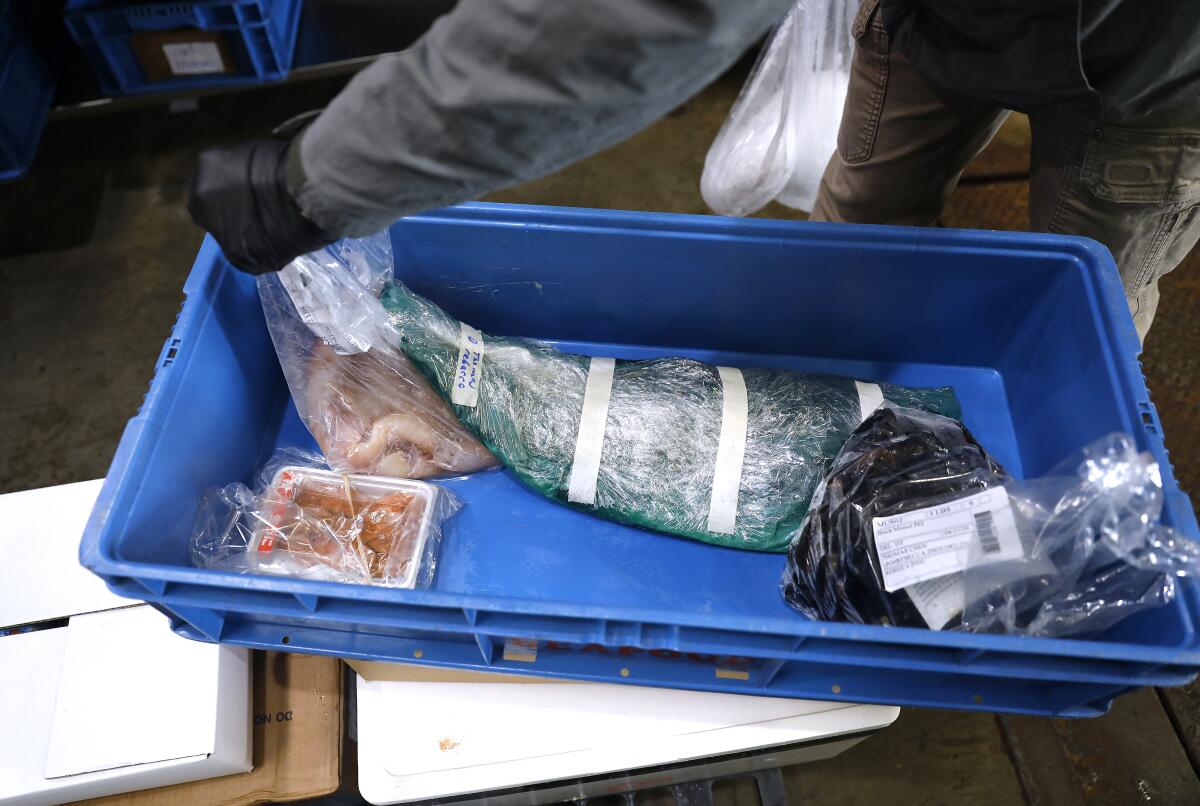
The total for my order at Luxe Seafood ended up around $200, providing enough fish to divvy up with friends. Even then, I still had plenty to make spicy tuna hand rolls, shoyu poke, baked salmon and homemade gravlax. Despite my lackluster slicing skills, it was pretty awesome.
“The response has been great so far,” Chen said. “The people who buy from us know what we’re trying to do. They’re sharing pictures of what they’re cooking, how they’re using the product. It’s encouraging.”
But as benevolent as my intentions were, the fish only arrived at the expense of others along the food chain: the fisherman, the importer, the delivery driver, even the hypothetical sushi chef on furlough. I couldn’t help but wonder: Was I supporting that system or taking advantage of it?
I asked Chen of Luxe Seafood if he thought, once stay-at-home orders had lifted and restaurants were allowed to reopen, he’d see more customers ordering his products directly instead of dining out. He considered for a minute, then demurred.
“I hope not,” he said. “Unless you are perfectly skilled at cutting tuna, most people would rather have a professional do it. That’s why we go to restaurants in the first place.”
More to Read
Eat your way across L.A.
Get our weekly Tasting Notes newsletter for reviews, news and more.
You may occasionally receive promotional content from the Los Angeles Times.
